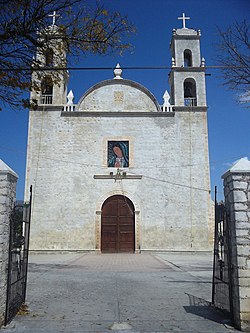Tixkokob Municipality (In the Yucatec Maya Language: “Place of the poisonous snakes”)[4] is a municipality in the Mexican state of Yucatán. Its municipal seat is located in the City of Tixkokob. The town of Tixkokob is famous within the area for high quality hammock weaving. The municipality made up largely of working class communities.
Tixkokob | |
|---|---|
 Church of Tixkokob, Yucatán | |
 Region 2 Noroeste #093 | |
| Coordinates: 21°00′N 89°24′W / 21.000°N 89.400°W | |
| Country | |
| State | Yucatán |
| Mexico Ind. | 1821 |
| Yucatán Est. | 1824 |
| Municipality Est. | 1923[1] |
| Area | |
• Total | 159.67 km2 (61.65 sq mi) |
| [1] | |
| Elevation | 8 m (26 ft) |
| Population | |
• Total | 16,151 |
| • Demonym | Tixkokobenses |
| Time zone | UTC-6 (Central Standard Time) |
| • Summer (DST) | UTC-5 (Central Daylight Time) |
| Postal Code | 97470 |
| Area code | 991 |
| INEGI Code | 093 |
| Major Airport | Merida (Manuel Crescencio Rejón) International Airport |
| IATA Code | MID |
| ICAO Code | MMMD |
Location
editTixkokob is located in the center of the Yucatán henequen zone, about 24 miles east of the city of Merida, capital of the state. Tixkokob is about halfway along the road from Merida to Izamal.
History
editIn antiquity, it was part of the province of Ceh-Pech. Upon the conquest, it became part of the encomienda system. It is referenced in a document dated 1549, indicating 540 indigenous persons affiliated with the encomendero.[4]
In 1821, Yucatán was declared independent of the Spanish Crown. In 1825 the area was part of the Coastal region, with its headquarters in Izamal. On 10 April 1843, 500 soldiers under the command of Lieutenant Colonel Francisco Pérez and General Peña y Barragán, defended the Mexican government against separatist Yucatecan forces in Tixkokob.[4]
In July 1867, Tixkokob was designated as a Villa by the State Congress. In 1914, it was elevated to the rank of city, but a few months later demoted again. In 1923 the ejido system was put in place and Tixkokob became a free pueblo.[4]
Governance
editThe municipal president is elected for a term of three years. The president appoints nine Councilpersons to serve on the board for three year terms, as the Secretary and councilors of culture, public image, public works, sports, ecology, cemeteries, parks and gardens, and nomenclature.[5]
Communities
editThe municipality is made up of 17 different communities, of which the most important are:
| Community | Population |
|---|---|
| Entire Municipality (2010) | 17,176[6] |
| Ruinas de Aké | 382 in 2005[7] |
| Ekmul | 2009 in 2005[8] |
| Euán | 1047 in 2005[9] |
| Nolo | 1459 in 2005[10] |
| San Antonio Millet | 588 in 2005[11] |
| Tixkokob | 10338 in 2005[12] |
Places of interest
edit- The archaeological zone of Ake is located in the municipality of Tixkokob, 15 kilometers from the township of Tixkokob.
- Cenote Yaax Ha
- Hacienda Ruinas de Ake
- Hacienda Hubila
- Hacienda Kankabchén
- Hacienda Kanyunyun
- Hacienda Katanchel
- Hacienda Nohchan
- Hacienda Oncan
- Hacienda San Antonio Millet
- Hacienda Santa María Chí
Notables
editNotable locals include the following:
Hernando Pech
Tixkokob chieftain who was accused of attending a Tehchamac human sacrifice, Tehchamac was located near the border of the province of Chepech Chacan.[1]
Ah Kin Chablé
Tixkokob priest, who served as an informant to Adelantado Montejo. The Maya priest converted to Christianity and took the name of D. Lorenzo Chablé.[1]
Arsenio Puerto Lara
A supporter of Carrillo Puerto and a member of the socialist league when she was young. Carrillo Puerto received the support of thousands of henequen workers. General Cardenas supported Lara to succeed General Canto Echeverria. In his tenure at the committee, Lara obtained significant benefits for the farmers of Tixkokob.[1]
Carlos R. Menéndez
Writer, journalist and historian (1872–1961), founder of the Printing Company currently publishes the newspaper Diario de Yucatán.[1]
References
edit- ^ a b c d e f g "Nuestros municipios - Tixkokob". Archived from the original on 21 May 2009. Retrieved 21 October 2009.
- ^ "Encyclopedia of the Municipalities of Mexico: Yucatan". Archived from the original on 20 November 2008. Retrieved 1 November 2009.
- ^ Census Results by Locality, 2005 Archived 2011-07-22 at the Wayback Machine INEGI.
- ^ a b c d "Municipios de Yucatán » Tixkokob". Gobierno del Estado de Yucatán (in Spanish). Mérida, Mexico: Gobierno del Estado de Yucatán. Retrieved 3 June 2015.
- ^ "Tixkokob". inafed (in Spanish). Mérida, Mexico: Enciclopedia de Los Municipios y Delegaciones de México. Retrieved 4 June 2015.
- ^ "Mexico In Figures: Tixkokob, Yucatán". INEGI (in Spanish and English). Aguascalientes, México: Instituto Nacional de Estadística y Geografía (INEGI). Archived from the original on 6 May 2015. Retrieved 6 May 2015.
- ^ "Aké". PueblosAmerica (in Spanish). PueblosAmerica. 2005. Retrieved 3 June 2015.
- ^ "Ekmul". PueblosAmerica (in Spanish). PueblosAmerica. 2005. Retrieved 3 June 2015.
- ^ "Euán". PueblosAmerica (in Spanish). PueblosAmerica. 2005. Retrieved 3 June 2015.
- ^ "Nolo". PueblosAmerica (in Spanish). PueblosAmerica. 2005. Retrieved 3 June 2015.
- ^ "San Antonio Millet". PueblosAmerica (in Spanish). PueblosAmerica. 2005. Retrieved 3 June 2015.
- ^ "Tixkokob". PueblosAmerica (in Spanish). PueblosAmerica. 2005. Retrieved 3 June 2015.
